
Sections
Explore
Digiday Media

For many retail brands, there are huge benefits for selling direct-to-consumer — including setting their own prices and freedom from restrictions that would otherwise be placed by distributors.
Many DTC brands set prices based on their own costs, as well as competitors’ pricing, but this strategy can be skewed by inherent preconceptions of the consumer’s point of view on price. The reality is that many consumers are often willing to pay more for what they perceive to be superior service or quality, and they aren’t considering product margins as part of the buying process.
In order for DTC brands to optimally price their products, they’ll have to examine metrics from all sides and gain a 360-degree view of the situation.
To help, in this guide you will learn:
Note: By entering your information you agree to be contacted by Modern Retail and its partners.
